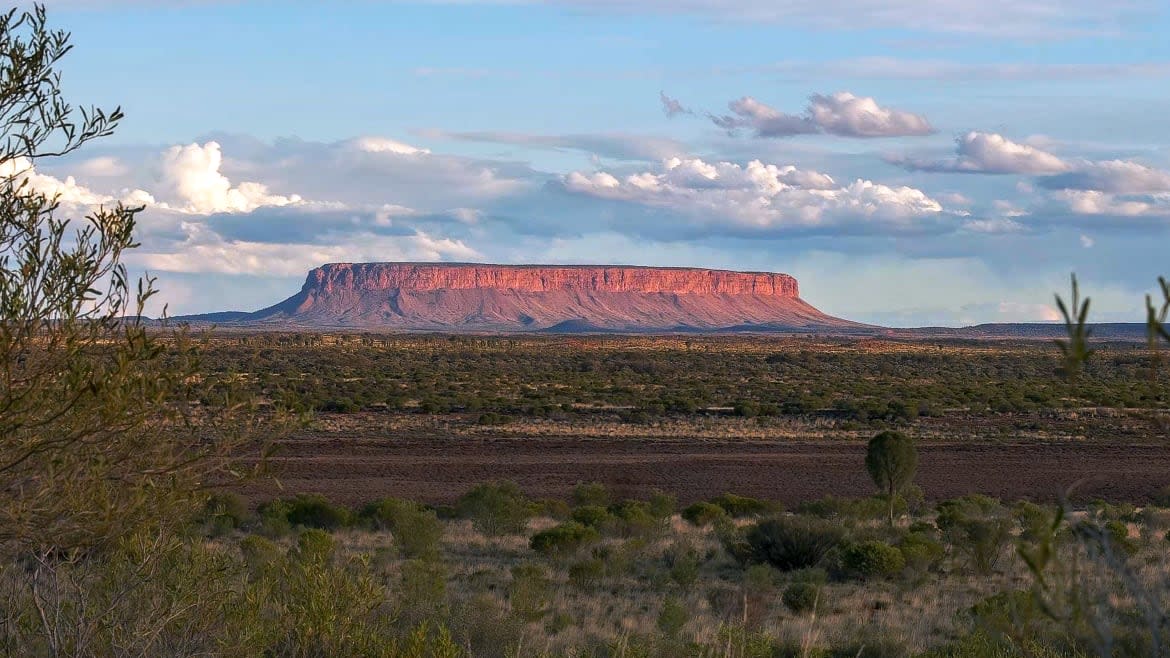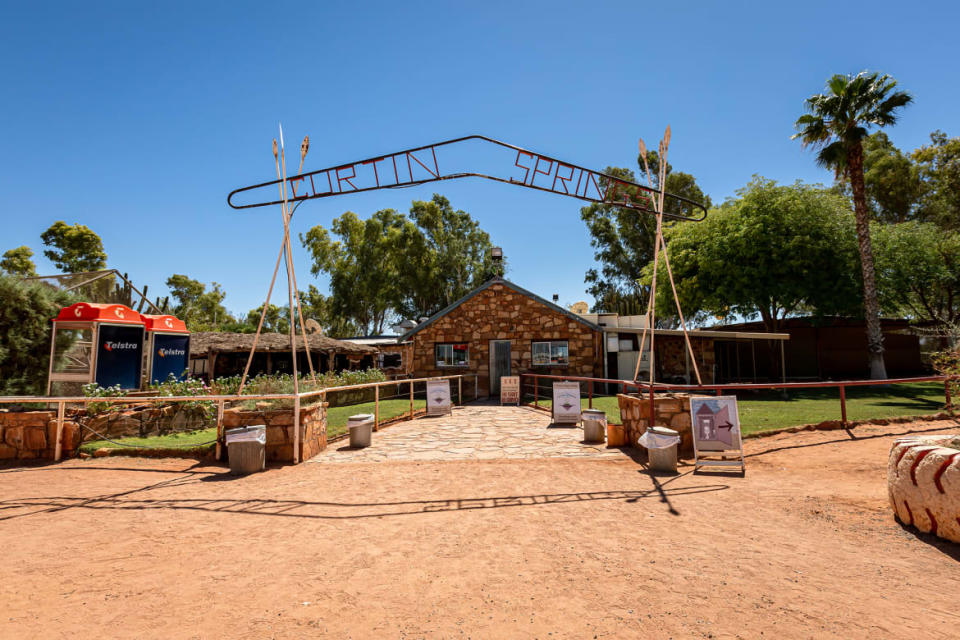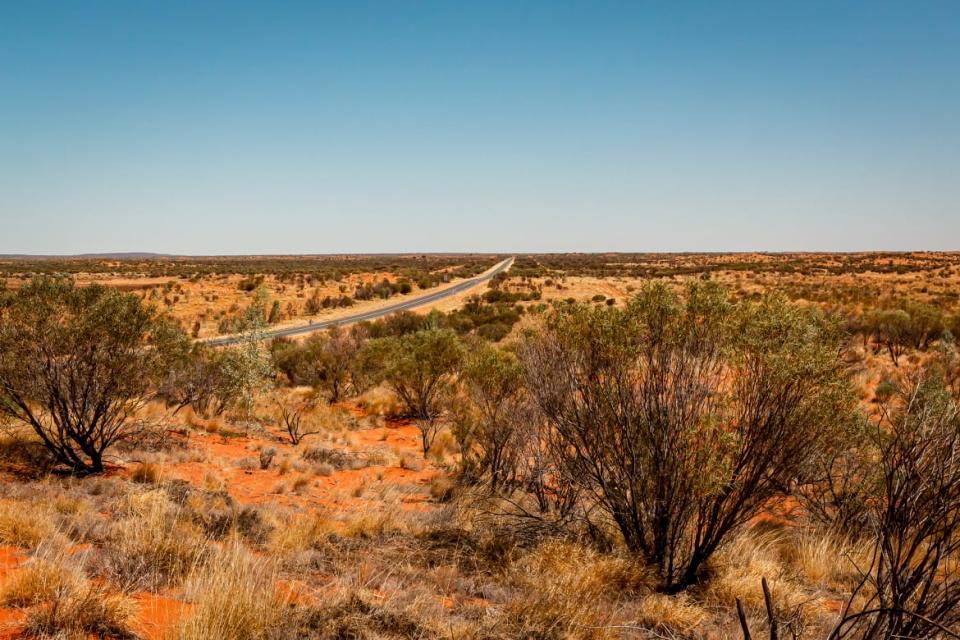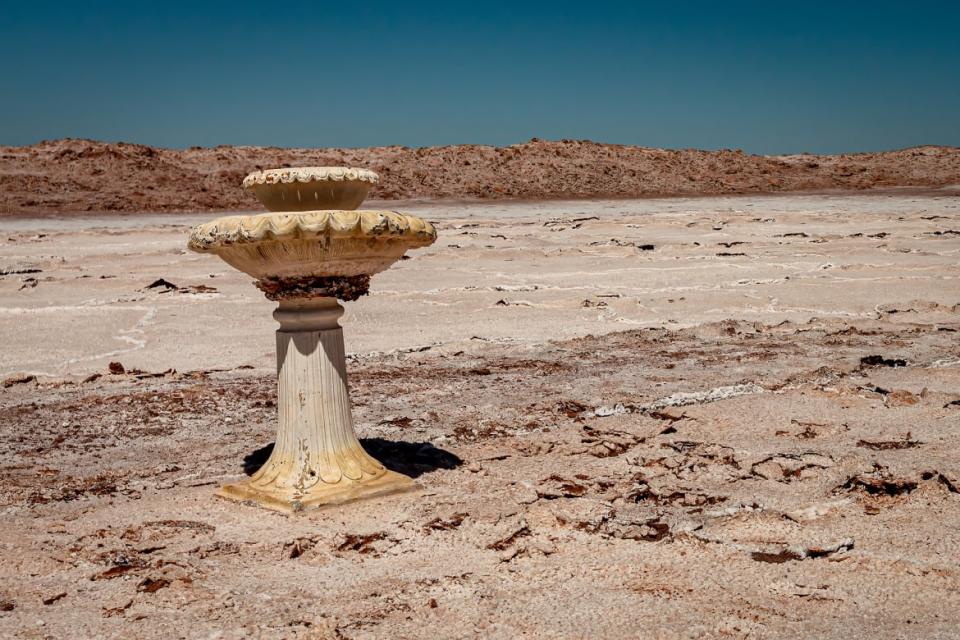The Fun of Finding the Wrong Landmark in the Australian Outback

As the car rolls along the flat, seemingly featureless desert expanse surrounding the Lasseter Highway, I suddenly spot a giant ochre rock in the distance. “We’re here,” I call out from the back seat. “There’s Uluru!”
As it turns out, we’re 100 kilometers (60 miles) northeast of Uluru, Australia’s iconic monolith formerly known as Ayers Rock. The massive tabletop rock I had seen is actually Mount Conner, aka “Fool-uru,” because so many people mistake it for Uluru.
Mount Conner, known as Artilla in the local Pitjantjatjara language, is located on a private property called Curtin Springs, which we turn into now. A 1 million-acre cattle station (ranch) surrounded by scrub, red sand, spinifex bushes, and salt flats, Curtin Springs is the ultimate Outback stopover experience. The site features a 27-room travelers’ inn and campsite, as well as a roadhouse, which in Australia means a gas station/garage with an attached restaurant, more like a diner.
When owner Peter Severin, his wife Dawn, and their young son Ashley, first moved here in 1956 with their 1,500 cows, the “next door station,” as Lyndee Severin, Ashley’s wife, puts it, “was 85 kilometers away.” At the time there were also no permanent Aboriginal settlements in the area since there was no regular source of water.
Locals love to recount the tale of how Severin took his wife, Dawn, to the property, which at that time didn’t even have proper shelter, and proudly showed her their new home. Evidently Dawn turned to him and said, “I’ve got news for you, and it’s all bad.”
OMG, I Want to Rent That House: Sydney, Australia
It’s hard to imagine why the Severins stayed on, given the isolation and the unforgiving desert environment. They got rain in their first year, and then came a nine-year drought. There were few visitors. Uluru wasn’t yet a tourist destination, and few had the inclination—or the vehicle—to take on the unpaved road to the Severin property. In their first year, the Severins received only six visitors: two family members, two government livestock agents, and two adventurous travelers.

The roadhouse at Curtin Springs, providing food and fuel for travelers in Australia’s Outback.
Despite the hardships, the Severins persevered. They found other ways to bring in money. Dawn offered afternoon tea with clotted cream and scones to the rare traveler who did stop in. They sold gas to passing travelers. They began serving meals and eventually opened the Wayside Inn.
Today Curtin Springs is a bustling cattle station, tourist inn, and refueling and rest stop at the crossroads between Uluru Kata-Tjuta National Park and Kings Canyon Watarrka National Park. A stay at one of the hotels at Ayers Rock Resort does not come cheap, and camping in the park is not permitted, so tourists often stay at Curtin Springs since it’s relatively close to Uluru. The campground is unpowered, but it’s free.
Curtin Springs is not your average roadside rest stop. To the right of the entrance, the shower block—one side for “sheilas,” misspelled “shielas,” the other for “blokes”—is plastered with cartoonish illustrations of sights in the area. Among some stones in the garden, skulls and bones of animals are displayed. An orphaned pet emu named Mongrel lives in a spacious enclosure. The huge bird used to wander freely, but evidently he plucked the laundry pins off the clothesline one too many times. The garden is also full of aviaries housing cockatoos, parrots, budgies, and other tropical birds. The birds belonged to Dawn, who during the first nine-year drought wanted to hear the call of a bird that was not a ubiquitous crow or galah (rose-breasted cockatoo).

Lasseter Highway from Curtin Springs.
The Severins are deeply attached to their land. Patriarch Peter Severin died in February 2021 at the age of 93, succeeded by his son Ashley who lives here along with his wife Lyndee and their children and grandchildren. “My family was raised here, our grandchildren were raised here,” says Lyndee. “Ash and I are still creating something. We’re responsible for the most amazing landscape and we’re very proud of how we look after it, and at the same time make it productive… We work very hard running two 24 hour/7-day-a-week businesses, but we chose to be here.”
My companions and I do a little bit of exploring before lunch. As I discover, the desert is not as featureless or lifeless as many might believe. The land here is studded with spinifex plants shooting straight up from the red sand, wildflowers, saltbush, and tall native grasses. The giant property is also home to at least 110 species of wild birds, including black falcons, Pacific herons, barn owls, and red backed kingfishers; dozens of different reptiles, from frogs, to geckos to bearded dragons; as well as rock wallabies, kangaroos, and dingoes.
We traipse up and over a rusty orange sand dune so Crayola bright it almost hurts the eyes and then explore one of the cattle station’s ancient salt lakes. Apart from an incongruous bird bath and tire tracks on the crystalline surface, there are no other signs of human civilization. Midday is not the best time to see the lakes, because the light is harsh, but interested visitors can join private evening and moonrise walks guided by Severin family members.

Bird bath on the salt flats.
The guided tours were Lyndee’s idea. “They’re an opportunity for visitors to get a little closer to the landscape—as well as sell more meals and bed nights for us!” she says. Through SEIT Ouback Tours, tourists can also book a champagne sunset tour and venture deep into the property, all the way to the base of Mount Conner, 25 kilometers in the distance.
Like Uluru, Mount Conner is sacred to the Pitjantjatjara people, who believe it to be the home of icemen who create cold weather. Uluru and Mount Conner are inselbergs, isolated rock hills or outcrops that stand above well-developed plains, and are part of the same, vast rocky substrate thought to lie deep beneath Uluru and the Kata Tjuta rock formations. Though many, like me, mistake it for Uluru, the 500-million-year-old rock formation is different in form, being flat-topped and horseshoe-shaped. Rising 859 meters above sea level and 300 meters above ground level, Mount Conner is four meters shorter than Uluru but about one kilometer longer.
While exploring the expansive property, it’s easy to forget that Curtin Springs is also a working cattle station. There’s no denying the environmental cost of beef production, which today has a justifiably bad rap, but that the Severins are raising cattle for beef is not immediately obvious. The Severins say they take the stewardship of the land seriously, working to minimize the impact of livestock on the country. Their 4,000 cows are also not trapped indoors and can wander around.
The family views their land as a “wildlife corridor.” “We don’t plant any crops, we don’t plow, we don’t fertilize, we don’t poison weeds,” says Lyndee. “So the landscape is run and protected as Mother Nature dictates. The cattle eat the native grasses. We run a conservative number of cattle and we don’t sell them when they reach a specific age… We don’t clear land, so all the native plants, reptiles, birds, mammals and everything else have their full habitats and food chains are in place. We live alongside these systems. Protecting the diversity of all the plants, animals, birds, etc., is absolutely vital.”
Peter Severin and his wife Dawn are credited with putting tourism on the map in the Uluru-Kata Tjuta region, a legacy their descendants are committed to perpetuating. And Curtin Springs as a tourist experience is unique. It’s certainly one of the quirkiest destinations I’ve visited Down Under. And in Australia’s desert Outback, that’s saying a lot!
Get the Daily Beast's biggest scoops and scandals delivered right to your inbox. Sign up now.
Stay informed and gain unlimited access to the Daily Beast's unmatched reporting. Subscribe now.

